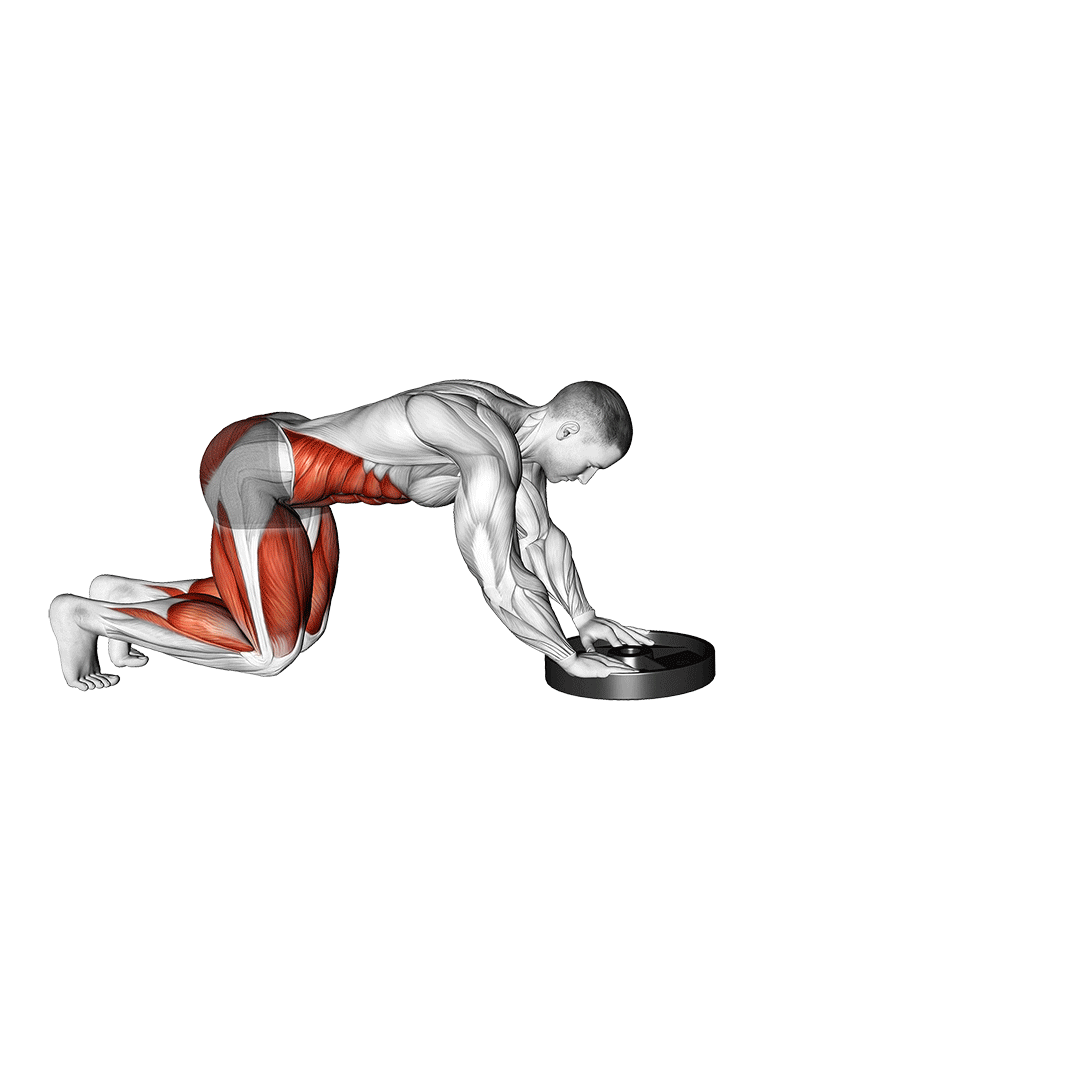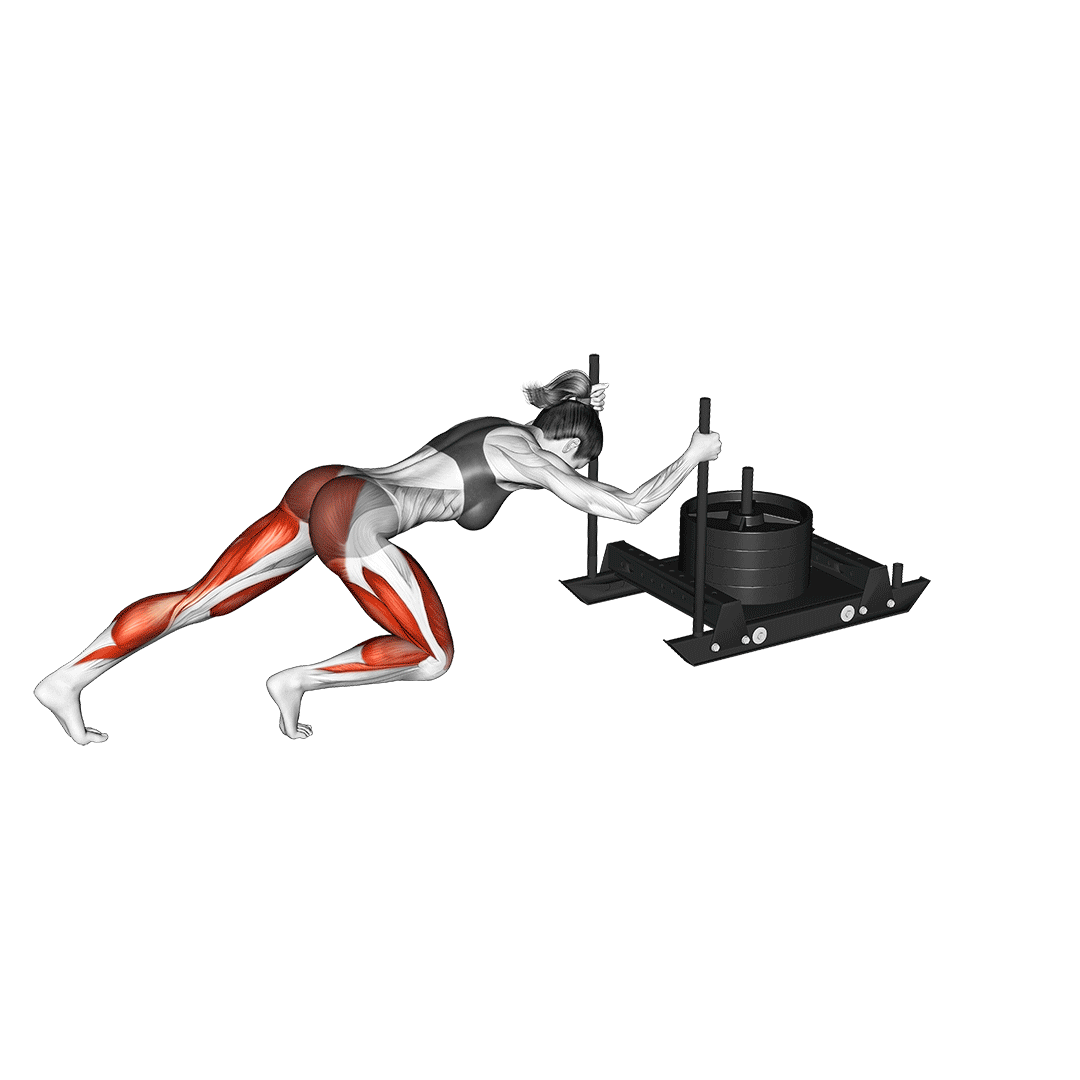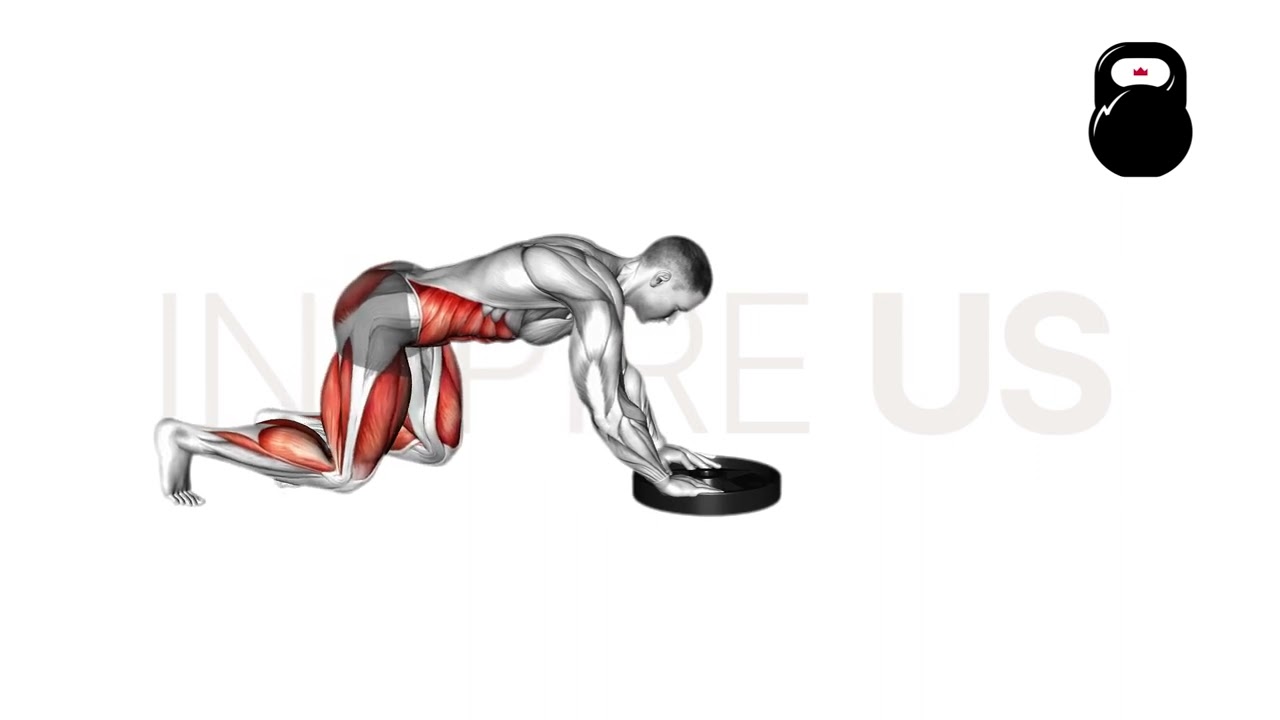Plates Pushes: Muscles Worked and More
The plate push is a sustained effort resistance exercise involving both aerobic and anaerobic training stimuli.
Apart from targeting the upper body push muscles and the legs, plate pushes also develop explosiveness, power and endurance.
What are Plate Pushes?
The plate push is a multi-muscle compound exercise primarily seen in athletic training as a builder of whole-body power and endurance.

Because plate pushes are measured by time or distance (rather than repetitions), including them into a strictly resistance exercise only program may be difficult. More often, they are seen in athletic drills or general fitness circuit training where they develop multiple aspects of the athlete’s physique simultaneously.
Depending on whether load, time working or distance is prioritized, plate pushes can be geared towards developing numerous forms of athletic ability.
The heavier the plate and the faster the push, the more explosiveness, speed and power are developed. Likewise, if a lengthy distance or time is prioritized, muscular endurance and caloric burn are focused on more intensely instead.
How to do Plate Pushes Correctly
To perform a plate push, the lifter will first set a plate down atop a suitable surface like turf, a weight sled lane or a carpeted area.
Crouching down and hinging the torso forwards so that both hands are flat atop one side of the plate, the lifter then contracts their core, faces the head forwards and ensures their back is flat from hip to neck.
Once in the correct stance, the lifter then takes one step forwards, maintaining tension in their upper body as they push the plate forwards. They will continue to step forwards, pushing the plate in this manner, until a sufficient distance or length of time has been reached.
Aim to select a relatively thick plate for plate pushes, as one that is too thin will require a more downward torso angle, challenging the lifter’s technique.
Sets and Time/Distance Recommendation:
For those new to the plate push or who wish to focus on speed, strength and power, 3-4 sets of 60-90 seconds each is sufficient.
For those that wish to maximize caloric expenditure or build up their endurance, 3-4 sets of 90-120 seconds may be better.
What Muscles are Worked by Plate Pushes?
Plate pushes are the very definition of a compound exercise, working multiple muscles simultaneously at a high level of intensity.

In order to better grasp what muscles are specifically worked best by plate pushes, we will have to divide them according to their role within the exercise itself.
For the sake of simplicity, muscles exhibiting dynamic contraction are referred to as “mobilizer” or “mover” muscles. Second to these are the “stabilizer” muscles, which exhibit isometric or static contraction, rather than dynamic.
Mobilizer Muscles
Regardless of stance or plate height, plate pushes will invariably emphasize the muscles of the lower body the most. This is especially true for the quadriceps femoris, gluteal muscles, the calves and the hamstrings.
However, in addition to these, the triceps brachii, anterior deltoid head, latissimus dorsi and pectoral muscles may also fulfill the role of mobilizer muscles, depending on whether they actively contract dynamically during the movement.
Stabilizer Muscles
Apart from the mobilizer muscles, the stabilizer muscles help keep the correct stance and stabilize the entire body during a plate push set.
These muscles are the abdominal muscles, obliques, erector spinae, trapezius and forearms - all of which contract isometrically.
Common Plate Push Mistakes to Avoid
To avoid injury and ensure your plate pushes are as beneficial as possible, avoid the following common mistakes.
Curving Lower Back
The most important error to look out for is rounding of the lower back.
Lifters with poor upper back mobility, poor core contraction or those who have placed the plate too close beneath their chest will have difficulty maintaining lower back neutrality.
If left uncorrected, this can easily lead to strains and injuries of not only the muscles therein, but also the underlying section of spine itself.
Aim to keep the entire back flat from glutes to the neck, with the core braced and the head facing forwards to help facilitate this neutrality.
Bending Knees Inwards
To help keep balance and ensure the knees are strained as little as possible, lifters should perform plate pushes with their knees pointing slightly outwards. Doing so will help distribute the pressure more advantageously through the knees, and aid in maintaining a balanced stance.
Hips Too High in Air
A similar mistake to poor lower back curvature is raising the hips too high in the air. From the side, it may appear that the body is forming a triangle with the glutes being the tip.
Placing the hips too high in the air will reduce the distance to which the legs can step forwards, as well as potentially place the lower back in a dangerous position. Not only will this significantly increase the lifter’s risk of injury, but it will also make the plate push far more difficult than necessary.
Essentially, the lifter should seek to keep the hips aligned with their waist as the back remains flat, positioning them in such a way that the legs can still take a significant step forwards.
Tucking Chin In
Although not as dangerous as other common mistakes, tucking the chin in while pushing the plate can extend the neck, causing the cervical spine to curve and leading to generally poor breathing in addition.
Keep the neck neutral and the eyes fixed forwards so as to allow for optimal breathing and better positioning of the upper back.
Poor Pacing
A commonly seen mistake with most sustained effort exercises is the performer beginning the set at too rapid a pace, causing them to fatigue and prematurely fail before the set itself is complete.
The plate push is no different in this regard, and unless the lifter is specifically training for maximal explosiveness and power, it is best for them to pace themselves at a sustained speed and intensity so as to avoid injury, failing the set or overly fatiguing themselves.
Alternatives and Variations of the Plate Push
If the plate push isn’t quite what you need out of your training, try the following alternatives out - each of which features a similar training stimulus but with different muscles worked or an altered stance.
Sled Push
The sled push is nearly identical to the plate push, only with the lifter instead performing the exercise upright and with the use of weighted sled.

Lifters that find the plate push to be too light, too inflexible or simply uncomfortable can easily substitute with the sled push for practically the same benefits.
In certain aspects, sled pushes may even be superior to the plate push - such as with overall lower back safety and incremental progression loading.
Rope Plate Pulls
A classic among Spartan race participants, rope plate pulls are the inverse of plate pushes where a rope is tied to a weight plate and pulled hand over hand towards the lifter.
Rather than working the lower body, rope plate pulls focus more on the back and elbow flexors, helping round out the training stimulus derived from plate pushes.
Use rope plate pulls as a partner exercise to plate pushes, rather than as a substitute. A full-body circuit or drill should ideally involve both exercises so as to properly develop both sides of the torso.
Walking Lunges
For a more strength-focused lower body exercise that can replace the plate push, walking lunges are the ideal candidate. Walking lunges will allow for even greater emphasis on the quadriceps and an overall more strict technique.

With a similar set of mechanics and intensity to plate pushes, all one needs to do is swap out distance or time with a number of repetitions instead.
Frequently Asked Questions (FAQ)
Are Plate Pushes Good for You?
Yes - plate pushes are excellent for improving cardiovascular fitness, strengthening the muscles of the legs and burning a few calories over a relatively short period.
Remember to perform the exercise with proper technique, and to only lift as much as you are reasonably able to do.
Are Plate Pushes the Same as Sled Pushes?
Not quite. Plate pushes involve a more horizontal torso orientation, less upper body involvement and a slightly greater risk of lower back injury when performed incorrectly. Furthermore, weight sleds are significantly easier to adjust in terms of total weight than simply stacking a pile of plates on the ground.
Can You Do Plate Pushes Every Day?
Ideally, no form of resistance exercise should be performed on a daily basis, let alone one as intense as plate pushes. Instead, aim to perform plate pushes at most 3 times a week, with at least one day of recovery in between workout sessions involving the plate push.
References
1. Tumminello, Nick. (2016) Building Muscle and Performance: A Program for Size, Strength & Speed. United States: Human Kinetics, 2016. ISBN: 9781492512707, 1492512702

